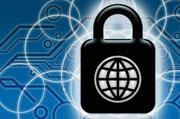Use iPad safely
iPad is a secure computing device. The combination of hardware and software security makes it a safer device than a PC or Mac, especially if proper security steps are applied.
So far, there has been no remote attack on the iPad, the biggest safety risk is the loss of the device. Therefore, the first step is to ensure that the device's data is safe in case the device is lost or stolen.
Encryption and encryption
 All iPads are manufactured with powerful built-in hardware encryption, but you need to enable this feature. The simple way to do this is to set a passcode for the iPad. As soon as the password is set, your data will be automatically encrypted. To activate a password, select Settings -> General -> Passcode Lock and enter a 4-digit code twice.
All iPads are manufactured with powerful built-in hardware encryption, but you need to enable this feature. The simple way to do this is to set a passcode for the iPad. As soon as the password is set, your data will be automatically encrypted. To activate a password, select Settings -> General -> Passcode Lock and enter a 4-digit code twice.
If you want to be more secure, you may not select the Simple Passcode option on the same page; At that time you can use longer code. When still on that page, you should also set Require Passcode (need to enter the password) no longer than 15 minutes and click Erase Data . (Technically, the iPad device will delete the decryption key, not actually delete the data, but doing so is faster and equally effective).
All modern iOS devices are also manufactured with a second encryption layer, called Data Protection . While the basic encryption feature is activated by opening passwords that protect all data on the device (including your applications), this feature can be resolved by intervention. jailbreak (jailbreak). Data Protection encrypts your email content and attachments; This feature cannot be unlocked even if the password has been solved by jailbreak. Data Protection is also provided for programmers using in the application, but few exploit this feature. (Currently, there is no jailbreak tool for iPad 2, so basic encryption is still safe; but this situation probably won't last long.)
Advanced encryption
 To make the iPad's built-in security features more robust, you can use the iPhone Configuration Utility. Designed to help businesses manage iOS devices, this utility provides an additional set of security features and settings for businesses, as well as individual users.
To make the iPad's built-in security features more robust, you can use the iPhone Configuration Utility. Designed to help businesses manage iOS devices, this utility provides an additional set of security features and settings for businesses, as well as individual users.
To use, select Configuration Profile -> New , and select Passcode from the displayed list. In the following Passcode frame, you have all kinds of options; The settings here will control your iPad. At least you can specify a minimum length for encryption.
To enable these password settings, you will also have to fill in some information on the General tab, especially the Profile name and identifier. If this is the only device you use, you can select Always in the Security drop-down box. (This way allows you to remove the profile when you want). If you configure the iPad for other users, you can choose Never or With Authorization (and then provide a password) so that this person cannot change the settings if you do not allow it.
Profile settings are easy to do: Click Share to email profile to your iPad. On this tablet, open Mail , find the letter, click on the attachment, and select Install . You can also export profiles to a file that can be downloaded and installed with the iPad Safari browser.
Enable remote wipe
Removing remote is an important security tool that allows you to delete data on lost iPads if and when this device connects to the Internet. If you have a MobileMe account, you can set up this account by activating the Find My iPad feature in Settings -> Mail , Contacts , Calendars -> MobileMe . Business users who connect to a Microsoft Exchange server (or other Exchange servers such as Kerio Connect) can delete their device with Exchange ActiveSync support. This is done on the server, not on your device, so you must do this with your IT administrator.
Remote wipe function only works if there is a network connection. That's why some companies only buy iPad 3G with data contracts.
Good safety habits
 Please note the settings. In addition, there are many things you can do when used daily to make your iPad safer.
Please note the settings. In addition, there are many things you can do when used daily to make your iPad safer.
One thing to do is make sure your network connections are as safe as possible. The best way is to use VPN virtual private network.
Another way is to use a secure connection for email. Microsoft Exchange servers encrypt data by default. If you use an IMAP or POP3 server, and it supports SSL, you can select Settings -> Mail , Contacts , Calendars -> your account -> Advanced on the iPad and enable this feature.
Although Data Protection encrypts your email attachments, when you send this document to an application like Pages , it is only protected by the iPad's basic encryption feature. If you really care about those documents, you can use a special security email server tool like Good for Enterprise and a free companion iPad app. Good tool blocks email attachments (and files downloaded from its secure browser) within the application, meaning you can read these documents, without correcting them. .
If you lose your iPad, one of the first things you should do is change your password on every service, like Dropbox or iDisk, that you connect to.
Finally, you should use the Password Pro application. This application helps you to have good coding habits (a complex password for each website), it syncs with your Mac and other devices over the Internet or with DropBox, and it stores recordings Security notes and other information such as passwords. The application also has an embedded browser of its own to log in to the site without having to copy-and-paste your account information.
You should read it
- Instructions for using security features in Samsung Galaxy S3
- What is data encryption? Things to know about data encryption
- How to enable Full-Disk Encryption on Windows 10?
- Top 20 best encryption software for Windows
- What is Hardware Security Module (HSM)? Why is it so important?
- Mexico's largest oil and gas corporation has been attacked by ransomware, presenting a cyber security disaster
- TrueCrypt encourages users to take other key measures
- Microsoft confirms a new serious security hole in Windows 10
May be interested
- Compare iPad Pro with M4 chip and iPad Pro with M2 chip
 the all-new ipad pro 2024 with m4 chip takes performance to the next level. so what upgrades did the previous ipad pro have? read the following article for a detailed look at ipad pro with m4 chip and ipad pro with m2 chip.
the all-new ipad pro 2024 with m4 chip takes performance to the next level. so what upgrades did the previous ipad pro have? read the following article for a detailed look at ipad pro with m4 chip and ipad pro with m2 chip. - IPad development history
 how has the ipad tablet changed since it was first published in 2010? join tipsmake.com to look at the history of ipad development through the following article!
how has the ipad tablet changed since it was first published in 2010? join tipsmake.com to look at the history of ipad development through the following article! - How to use LinkSafe to safely shorten links
 to shorten links, you currently have many different support tools for you to choose and use, and linksafe is one such service.
to shorten links, you currently have many different support tools for you to choose and use, and linksafe is one such service. - Measures to enhance security on the iPad
 ipad is a revolution in mobile devices and can be used for many different purposes. however, like any other computing tool, it is sensitive to online attacks such as hacking, unauthorized intrusion or information theft. here are the methods to improve the security level on ipad, gi &
ipad is a revolution in mobile devices and can be used for many different purposes. however, like any other computing tool, it is sensitive to online attacks such as hacking, unauthorized intrusion or information theft. here are the methods to improve the security level on ipad, gi & - Next time your iPad breaks, you can fix it yourself!
 apple has announced an expansion of its self-service repair program to include certain ipad models. the company's genuine parts and resources can help you take care of your expensive ipad (if you're confident in your diy repair skills).
apple has announced an expansion of its self-service repair program to include certain ipad models. the company's genuine parts and resources can help you take care of your expensive ipad (if you're confident in your diy repair skills). - How to jump Vent safely, jump safely Vent in Among Us
 if you want to use vent safely in among us, please refer to the content in this article. because there are little things that you do not know about the sewer system in among us.
if you want to use vent safely in among us, please refer to the content in this article. because there are little things that you do not know about the sewer system in among us. - Apple may launch cheap tablets to increase sales
 the ipad is great, but they're too expensive. this may change in the future.
the ipad is great, but they're too expensive. this may change in the future. - iPad Pro 2018, super strong configuration, screen overflow border, Face ID
 apple's latest ipad pro was officially launched on october 30 with a new design and a tremendous configuration.
apple's latest ipad pro was officially launched on october 30 with a new design and a tremendous configuration. - Things to do to 'stay healthy' on Windows 7 after the operating system has been killed
 windows 7 has officially been retired, marking the end of an era that is ingrained in the minds of millions of computer users around the world.
windows 7 has officially been retired, marking the end of an era that is ingrained in the minds of millions of computer users around the world. - Instructions to fix iPad errors are disabled
 in this is the guide to unlock the iphone, ipad is locked due to entering the wrong password many times
in this is the guide to unlock the iphone, ipad is locked due to entering the wrong password many times










 Encrypt the hard drive to protect your data
Encrypt the hard drive to protect your data Encrypt Dropbox data storage partition with BoxCryptor
Encrypt Dropbox data storage partition with BoxCryptor Google Hijack - Search results are redirected
Google Hijack - Search results are redirected Microsoft provides security patches for Windows, IE
Microsoft provides security patches for Windows, IE 10 tips to help Windows security
10 tips to help Windows security ScanPack: digital solution and 'peeling' document layer
ScanPack: digital solution and 'peeling' document layer